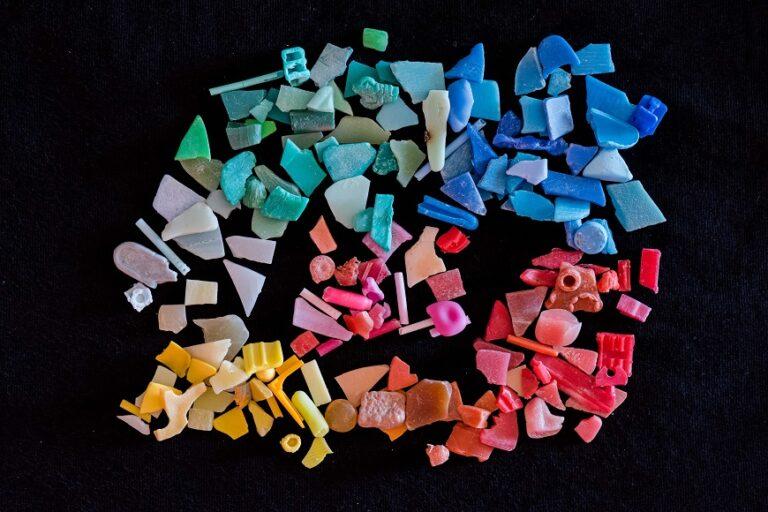Microplastic has no generally accepted, harmonised definition, but typically refers to plastic particles smaller than 5 mm found in the environment. Nanoplastic can be described as any plastic material that has all three dimensions in the size range of 1-100 nm defined by ISO standards or that does not have a large difference between the longest and shortest axes (less than three times). If the deviation is larger, other terms, e.g. nanofibre, should be used.
Micro- and nanoplastics are typically created by the degradation of larger plastics (secondary plastics). The main reason for their development is the increasing plastic pollution, which has become one of the biggest environmental problems of our time. Roughly 80% of the plastic waste in the world's seas and oceans comes from rivers. According to a new study, it is not the rivers with the highest water yields or catchment areas that dump most of the litter into the oceans, with smaller rivers playing a much larger role than previously thought. The most polluted rivers typically flow through areas with poor waste management or large cities and are often close to the coast. According to the study, around 80% of plastic waste discharged into the oceans comes from Asian rivers.
Source: https://multimedia.europarl.europa.eu/en/microplastic-pollution_N01-PUB-181119-MPLAS_ev
Micro- and nanoplastics were first explored in the oceans and marine environments, but are now present in freshwater, lakes and rivers, as well as in bottled and tap water. A study published in 2020 reported that microplastic contamination was also found in ice samples from Antarctica. The microplastic contamination of the freshwaters in Hungary has been already investigated. Although the presence of micro- and nanoplastics in the rivers of Hungary is a problem that needs to be addressed, the quality of drinking water in Hungary is not yet significantly affected, largely due to the fact that 94% of our drinking water comes from groundwater which is more protected from plastic pollution.
According to a study published in the journal Science, thermohaline-driven currents can control the distribution of microplastics and create hot spots with concentrations of up to 1.9 million microplastics per square metre. These currents also transport oxygen and nutrients to deep-sea benthos. Thus, it can be assumed that deep-sea biodiversity hotspots are also likely to be microplastic hotspots.
In a study published in 2021, it was pointed out that the atmosphere also contains significant amounts of microplastics. The particles can float in the air for up to 6 days and can travel considerable distances in the air currents.
Such a high environmental presence of microplastics means that the particles are also entering the food chain. Plastic fragments were found in the digestive tract of several organisms, mainly marine animals, e.g. fish, shellfish and crustaceans. In laboratory conditions, it has also been observed that microplastics can be translocated to the circulatory system or to the organs. Microplastics can cause physical injury and inflammatory processes in the animal's digestive system, and in extreme cases can lead to the death of the animal.

Credit: Dr. Marcus Eriksen, 5 Gyres Institute
In addition, microplastics can leach harmful compounds into living organisms, such as toxic or endocrine-disrupting substances used during the production of plastics (bisphenol A, phthalates and polybrominated diphenyl ether used as flame retardants). Another problem is that plastic fragments can also bind other contaminants present in water (e.g. polycyclic aromatic hydrocarbons - PAHs, polychlorinated biphenyls, DDT) on their surface, which can enter the organism in a much more concentrated form than their environmental counterparts. Less researched compounds, such as bis(4-chlorophenyl) sulfone (BCPS), are also being detected in marine fish at increasing concentrations compared to previously measured results, suggesting a high level of biomagnification.
A further problem is that pathogenic bacteria and viruses can colonise the surface of the microplastics in the water, which by ingesting the microplastics, can then enter fish and other marine organisms and subsequently the human body. However, a study stresses that their pathogenicity and virulence potential are not yet known, nor is it clear whether humans can be infected by such transmission.
Today, we have to deal with microplastic pollution not only in aquatic organisms, but also in terrestrial animals and plants. A study published in 2020 reported that microplastics have been detected in vegetables and fruits. According to their tests, apple and carrot samples were the most contaminated, while lettuce was the least. The smallest particle (1.51 μm) was detected in carrots, the largest (2.52 μm) in lettuce.
The accumulation of nanoplastics in plants can have direct ecological impacts and consequences for agricultural sustainability and food safety. In an experiment (Arabidopsis thaliana), a type of weed, was exposed to plastics smaller than 100 nanometres and found that nanoplastics reduced the total biomass of model plants: plants exposed to nanoplastics were smaller and had shorter roots, compromising the nutritional value of the plants. This was the first study to confirm the uptake and accumulation of nanoplastics in terrestrial plants at the tissue and molecular level, using microscopic, molecular and genetic approaches.
In a study published in 2021, it was reported that microplastics were also found on the bodies of honey bees, which could be incorporated into honey.
Micro- and nanoplastics can enter the human digestive system and body through the consumption of contaminated food. According to a previous research, a person consumes approximately 5 grams of plastic per week, which is roughly the weight of a credit card. That's a quarter of a kilo of plastic per person per year. According to an international study, bottled water can be a major source for human consumption of microplastics. The study found that people who drink only bottled water can ingest up to 90.000 microplastics annually, compared to 4.000 particles for those who consume only tap water.
A Swedish study on micro- and nanoplastic contamination in drinking water has attempted to perform a risk assessment. Exposure to organic pollutants and Bisphenol A (BPA) absorbed to microplastics was assessed and it was concluded that the theoretical exposure to BPA from microplastics was negligible compared to the tolerable intake set by EFSA. WHO also stated that "based on the limited evidence available, chemicals and microbial pathogens associated with microplastics in drinking water pose a low concern for human health".

Little is known about the effects of ingested micro- and nanoplastics on human metabolism and the health risks they can cause. For some groups, exposure to microplastic pollution may pose a higher risk. Of concern may be the discovery of microplastics in human placenta, in the maternal, fetal and amniochorial membranes. The particles may affect the development and growth of the foetus. A study published in the journal Nature found that a lot of microplastics are released from polypropylene feeding bottles during sterilization with hot water. The researchers stressed that their aim is not to cause panic, as the health implications are not yet clear, but suggested reducing the intake of microplastics by shaking and heating the plastic bottle as little as possible.
There is no consensus among the experts regarding the impact of microplastics on animal and human health and the significance of plastic pollution in the diet. According to the EFSA statement, at least 90% of ingested micro- and nanoplastics will be excreted without any problems, but the remainder, typically smaller nanoparticles, may translocate across the gut epithelium, and enter cells.
According to a Spanish study, although anthropogenic fibres were detected in the digestive tracts of most of the crabs studied, which in many cases formed tangled balls in the stomach of the animals, the animals appeared healthy and no major histological changes or alterations from the normal tissular pattern were observed. The researchers thus concluded that the consumption of crabs does not pose a serious risk to human health, partly because the parts of crabs in which most of the microplastics are found are not typically consumed, and partly because we are exposed to much higher intakes from other sources.
Besides food, micro- and nanoplastics can also enter the body through other routes, such as inhalation. Although small plastic particles can be found in cosmetics, no evidence of transdermal transmission has been found so far.
We are faced with many uncertainties and unanswered questions on the subject. Our current knowledge is not sufficient to carry out a "traditional risk assessment", including how much micro- and nanoplastic intake can be considered acceptable. There are also no adequate animal studies on the subject that could be used for risk assessment purposes. Although marine organisms have been studied, very different effects have been observed.
It would be important to investigate the presence of micro- and nanoplastics in foods that have been less researched (e.g. meat, dairy products, vegetables, fruit, processed foods) or to carry out comprehensive assessments that take into account exposure from multiple sources (food, inhalation).
Further studies are needed to clarify whether micro- and nanoplastics entering the human body actually have any health effects and, if so, by what mechanisms of action. The hypothesis that plastic particles entering the body may interact with the immune system, e.g. by causing inflammation, has not yet been sufficiently proved.
Laboratory testing of micro- and nanoplastics also faces challenges. There are typically two main lines of investigation: physical (size, shape and colour) and chemical (type of plastic). These analyses are highly complex, involving extraction, isolation, identification and quantification techniques. Currently, researchers use several analytical methods to characterise and quantify micro- and nanoplastics, so the results obtained are often not comparable. It is therefore important to develop internationally accepted and validated standard protocols for the detection, identification and quantification of micro- and nanoplastics.
Further studies and methodological developments are needed to address the methodological challenges and open questions related to micro- and nanoplastics. As long as knowledge gaps are not filled, micro- and nanoplastics are likely to remain a research priority, and it may be worthwhile for professionals and young researchers interested in this topic to get involved in research on them.
Updates
Microplastics have been found in human lung tissue and blood
Microplastic particles have been detected in the lungs of living humans.
Microplastic pollution has been detected in human blood for the first time. Scientists identified the plastic particles in almost 80% of the people tested (17 out of the 22 samples). Half of the samples contained PET plastic, which is commonly used in drinks bottles, a third contained polystyrene, used for packaging food and other products, a quarter of the blood samples contained polyethylene, from which plastic carrier bags are made. The impact of microplastics on the human health is still unclear, but it is concerning that the particles can be transported throughout the body and may lodge in organs. Researchers state that further studies are needed, e.g. with bigger sample sizes, increasing the number of polymers assessed, etc.
Microplastics in breast milk
After human placenta, Italian researchers found microplastics in human breastmilk as well. In the new study, the breast milk of 34 healthy mothers was tested one week after birth and 75% of the milk showed the presence of different microplastics: polyethylene, PVC and polypropylene.
The researchers found no association between the presence of microplastics in breast milk and the subjects' use of personal care products, consumption of plastic-packaged foods and drinks, or seafood in the 7 days before and after birth. This suggests that, due to the widespread presence of microplastics, exposure to particles is unavoidable and it is impossible to isolate a specific source from the complex exposures.
Levels of exposure to microplastics and effects on human health
Several recent scientific studies have assessed human exposure to microplastic particles and analysed the possible associated health effects.
According to Chen et al., 2022, the amount of microplastic particles emitted from disposable cups ranges from 1,000 to 5,000 particles per litre.
Zhou and colleagues estimated that drinking from a plastic cup every four to five days can lead to an intake of 37.613 to 89.294 microplastic particles per year.
Zha et al., 2022 concluded that occasional and frequent consumption of disposable plastic containers may cause changes in the composition, structure and pathways of the gut and oral microbiota, leading to gastrointestinal dysfunction and cough.
Tavelli and colleagues conducted a review study on the pathogenic bacteria that adhere to the surface of plastic particles and are carried with the particles into food. They identified gaps in knowledge or inconclusive results on the binding of microbial toxins to plastic particles and the effect of microplastics on microbial virulence and evolution. Overall, the authors conclude that biofilm-coated microplastics in food may pose a number of risks to food safety, but further research is needed to determine the extent of their impact on human health.
According to a review study microplastics cause damage to human cells in the laboratory at the levels known to be eaten by people via their food. Based on the results of studies included in the review, microplastics might cause specific types of harm – cell death, allergic response, and damage to cell walls. It is important to point out that the researchers came to this conclusion based on the results of in vitro toxicological studies, as human epidemiological data are not available.
FAO's new publication titled Microplastics in food commodities – A food safety review on human exposure through dietary sources outlines the existing literature on the occurrence of microplastics and their associated contaminants in foods. It also estimates the dietary exposure of consumers to these materials; highlights some knowledge gaps with respect to their relevance to public health; and offers some recommendations for future work on microplastic particles to support food safety governance.
Microplastics in the soil and plants
Microplastics are identified as emerging persistent pollutants present widely in ecosystems, with measurements in agricultural soils ranging from 10's to 1,000's of particles per dry kilogram. Their presence in soils affects various soil properties, such as aeration, water repellence, and porosity, while decreasing soil bulk density and aggregate sizes.
Soil microorganisms can be affected by microplastics. There are effects on species dominance, diversity and richness reported in the literature and microplastics have been found to cause oxidative stress and abnormal gene expression in earthworms.
The impact of microplastics on terrestrial plants, particularly crops, is not fully understood. Micro- and nanoplastics, due to their small size and adsorption capacity, can hinder seed germination, root elongation, water and nutrient absorption, ultimately inhibiting plant growth. The adherence and accumulation ofmicroplastics can induce oxidative stress in plants, leading to changes in growth, nutrition, photosynthesis, and metabolites. The phytotoxicity of the plastic particles varies based on factors like polymer type, size, dose, and shape, as well as plant tolerance and exposure conditions. The accumulation of plastic pieces in plants may have implications for crop productivity, food safety, and quality, posing potential health risks.

